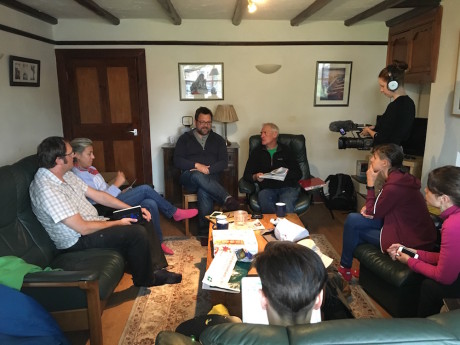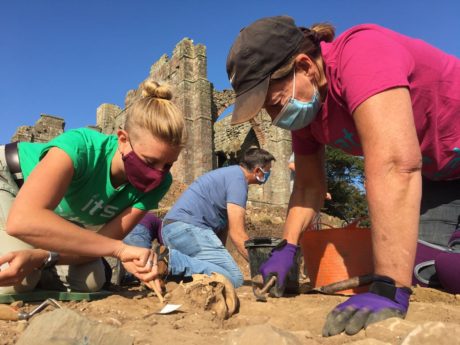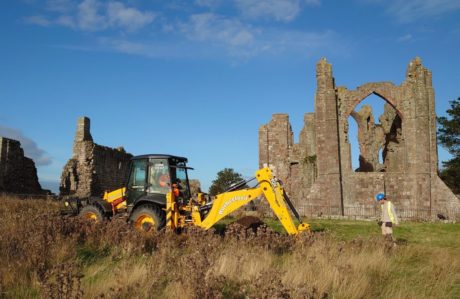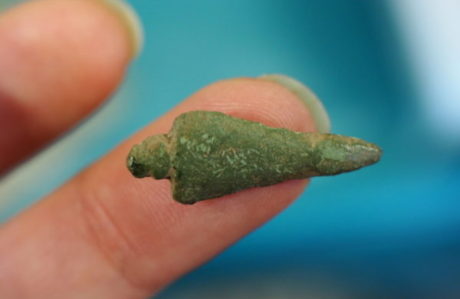
Deep inside DigVentures HQ, the archaeologists have gathered to discuss plans for the dig. It’s the last meeting before the diggers arrive, and a final chance for the team to recap on what we’re looking for, where we’re going to put our trenches and what we’re hoping to find inside them…
Lindisfarne is a place that needs little introduction. Historically, it’s notorious for being one of the first places that the Vikings raided in the British Isles in AD 793, and marking the start of the Viking Age. While the Anglo-Saxon monastery they attacked is exactly what we’re looking for, there’s far more to its story than that…
Originally founded by King Oswald and St Aidan in AD 635, this monastery was the ying to Bamburgh Castle’s yang. Together, these two sites formed the religious and political heart of the great Anglo-Saxon kingdom of Northumbria.
And yet, most of our knowledge of Lindisfarne’s Anglo-Saxon monastery is inferred; surprisingly little is known archaeologically. Given the site’s influence, and its iconic place in English history, it’s almost incomprehensible to us that no-one has ever really made a serious effort to find it, or to understand what glimpses of Northumbrian early medieval history we might catch if only we looked below the ground.
To find out, we’ve placed three trenches, on either side of the village. Here’s what we’re hoping to find…
An Anglo-Saxon monastic building
We’re placing two small trenches on the eastern side of the village, just to the side of the later medieval priory. This is where a series of linear features showed up on the geophysical survey. We’re not yet sure what they are, but we’ve got plenty of good reasons to think that a substantial part of the early medieval monastery was built in this area.
Early medieval monasteries were very different in their layout to later medieval ones. Simply put, the early monks at Lindisfarne had a very different way of doing monasticism. For a start, they were much less inward looking, didn’t yet have cloisters, had not yet formed the orders we know of from the later medieval, spread their buildings over a wider area in a less formulaic fashion, and had several churches… including one which the monks actually disassembled and took with them when they the island in AD 875.
While most of the buildings were made of wood, it was the churches that were most likely to be made of stone. If these linear features turn out to be one of the early medieval churches, it would be a really major discovery.
The edge of the monastery
We’re also placing another trench on the western side of the village and this is where we’re hoping to find the edge of the monastery.
Pretty much everything we know about Lindisfarne’s original layout is inferred from a few historical sources. Finding the edge of the monastery is really the starting point for any serious investigation.
There are several theories about where the inner boundary might lie, and establishing just where and how far out it is will give us an area within which to look in more detail in future, and will also be a major achievement in beginning to map the site’s original layout.
Hardcore monks and heavy metals
As well as looking for the edge of the monastery, we’re looking for evidence of some of the things that happened at those edges – things that the monks purposefully did away from the centre of their monastery, things that were somehow unpleasant…
One of those things is metalworking. We’re got evidence of possible metalworking showing up on the geophysics results, and we know that on other early medieval monastic sites, archaeologists have indeed found the remains of these activities carried out near the boundary.
If we can find evidence of the heavier, industrial activities, and date it accurately, we could start to address some of the questions we have about what happened after the Vikings attacked. We know that the monks clung on for 80 or so years, before most of them decided to leave. But there are some suggestions that a hardcore contingent stayed behind and stuck it out for even longer. What did they do? How long did they carry on? And how did they manage? These are all questions we could begin to answer.
Signs of life
We’ve heard that archeologists excavating at Aberlady have been turning up early medieval artefacts right, left and centre – from bone combs to Northumbrian coins.
Lindisfarne was one of the foremost complexes of the time and while finding artefacts is not our priority, anything we do find will help us understand early medieval life even better.
The truth, the whole truth and nothing but the groundtruth…
With all that said, what we’re really, really hoping to find out is simply whether the geophysics results are telling us the truth… are there structures where they say they are, and are they really Anglo-Saxon?


